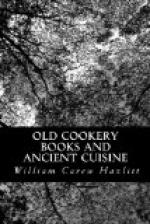There was necessarily a very large section of the community in all the large towns, especially in London, which was destitute of culinary appliances, and at the same time of any charitable or eleemosynary privileges. A multitude of persons, of both sexes and all ages, gradually developed itself, having no feudal ties, but attached to an endless variety of more or less humble employments.
How did all these men, women, boys, girls, get their daily food? The answer is, in the public eating-houses. Fitzstephen tells us that in the reign of Henry II. (1154-89), besides the wine-vaults and the shops which sold liquors, there was on the banks of the river a public eating-house or cook’s-shop, where, according to the time of year, you could get every kind of victuals, roasted, boiled, baked, or fried; and even, says he, if a friend should arrive at a citizen’s house, and not care to wait, they go to the shop, where there were viands always kept ready to suit every purse and palate, even including venison, sturgeon, and Guinea-fowls. For all classes frequented the City; and before Bardolph’s day noblemen and gentlemen came to Smithfield to buy their horses, as they did to the waterside near the Tower to embark for a voyage.
One of the characters in the “Canterbury Tales”—the Cook of London—was, in fact the keeper of a cook’s-shop; and in the Prologue to the Tale, with which his name is associated, the charming story of “Gamelin,” the poet makes the Reeve charge his companion with not very creditable behaviour towards his customers. So our host trusts that his relation will be entertaining and good:—
“For many a pasty hast thou let
blood,
And many a Jack of Dover[1] hast thou
sold,
That hath been twice hot and twice cold.
Of many a pilgrim hast thou Christ’s
curse—
For thy parsley fare they yet the worse:
That they have eaten with the stubble
goose,
For in thy shop is many a fly loose.”
[Footnote 1: A sole]
But these restaurants were not long confined to one locality. From a very early date, owing perhaps to its proximity to the Tower and the Thames, East Cheap was famed for its houses of entertainment. The Dagger in Cheap is mentioned in “A Hundred Merry Tales,” 1526. The Boar is historical. It was naturally at the East-end, in London proper, that the flood-tide, as it were, of tavern life set in, among the seafarers, in the heart of industrial activity; and the anecdotes and glimpses which we enjoy show, just what might have been guessed, that these houses often became scenes of riotous excess and debauch. Lydgate’s ballad of “London Lickpenny” helps one to imagine what such resorts must have been in the first part of the fifteenth century. It is almost permissible to infer that the street contained, in addition to the regular inns, an assortment of open counters, where the commodities on sale were cried aloud for the benefit of the passer-by; for he says:—




